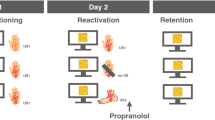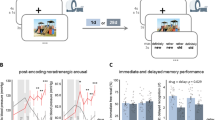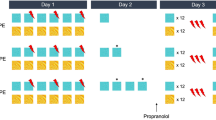Abstract
The noradrenergic system plays a critical role in the ‘consolidation’ of emotional memory. If we are to target ‘reconsolidation’ in patients with anxiety disorders, the noradrenergic strengthening of fear memory should not impair the disruption of reconsolidation. In Experiment I, we addressed this issue using a differential fear conditioning procedure allowing selective reactivation of one of two fear associations. First, we strengthened fear memory by administering an α2-adrenergic receptor antagonist (ie, yohimbine HCl; double-blind placebo-controlled study) 30 min before acquisition (time for peak value yohimbine HCl <1 h). Next, the reconsolidation of one of the fear associations was manipulated by administering a β-adrenergic receptor antagonist (ie, propranolol HCl) 90 min before its selective reactivation (time for peak value propranolol HCl <2 h). In Experiment II, we administered propranolol HCl after reactivation of the memory to rule out a possible effect of the pharmacological manipulation on the memory retrieval itself. The excessive release of noradrenaline during memory formation not only delayed the process of extinction 48 h later, but also triggered broader fear generalization. Yet, the β-adrenergic receptor blocker during reconsolidation selectively ‘neutralized’ the fear-arousing aspects of the noradrenergic-strengthened memory and undermined the generalization of fear. We observed a similar reduction in fear responding when propranolol HCl was administered after reactivation of the memory. The present findings demonstrate the involvement of noradrenergic modulation in the formation as well as generalization of human fear memory. Given that the noradrenergic strengthening of fear memory impaired extinction learning but not the disruption of reconsolidation, our findings may have implications for the treatment of anxiety disorders.
Similar content being viewed by others
Log in or create a free account to read this content
Gain free access to this article, as well as selected content from this journal and more on nature.com
or
References
Baeyens F, Eelen P, van den Berg O (1990). Contingency awareness in evaluative conditioning: a case for unaware affective-evaluative learning. Cogn Emot 4: 3–18.
Blechert J, Michael T, Vriends N, Margraf J, Wilhelm FH (2007). Fear conditioning in posttraumatic stress disorder: evidence for delayed extinction of autonomic, experiential, and behavioural responses. Behav Res Ther 45: 2019–2033.
Bouton ME (1993). Context, time, and memory retrieval in the interference paradigm of Pavlovian learning. Psychol Bull 114: 80–99.
Brewin CR, Andrews B, Valentine JD (2000). Meta-analysis of risk factors for posttraumatic stress disorder in trauma-exposed adults. J Cons Clin Psychol 68: 748–766.
Brunet A, Orr SP, Tremblay J, Robertson K, Nader K, Pitman RK (2008). Effect of post-retrieval propranolol on psychophysiological responding during subsequent script-driven traumatic imagery in post-traumatic stress disorder. J Psych Res 42: 503–506.
Charney DS, Woods SW, Goodam WK, Heninger GR (1987). Neurobiological mechanisms of panic-anxiety: biochemical and behavioral correlates of yohimbine-induced panic attacks. Am J Psych 44: 1030–1036.
Davies MF, Tsui J, Flannery JA, Li X, DeLorey TM, Hoffman BB (2004). Activation of α2 adrenergic receptors suppresses fear conditioning: expression of c-Fos and phosphorylated CREB in mouse amygdala. Neuropsychopharmacology 29: 229–239.
Davis M, Falls WA, Campeau S, Kim M (1993). Fear-potentiated startle: a neural and pharmacological analysis. Behav Brain Res 58: 175–198.
Debiec J, LeDoux JE (2004). Disruption of reconsolidation but not consolidation of auditory fear conditioning by noradrenergic blockade in the amygdala. Neuroscience 129: 267–272.
Dudai Y (2006). Reconsolidation: the advantage of being refocused. Curr Opin Neurobiol 16: 174–178.
Dudai Y (2009). Predicting not to predict too much: how the cellular machinery of memory anticipates the uncertain future. Philoso Trans R Soc B 364: 1255–1262.
Eisenberg M, Kobilo T, Berman DE, Dudai Y (2003). Stability of retrieved memory: inverse correlation with trace dominance. Science 301: 1102–1104.
Filion DL, Dawson ME, Schell AM, Hazlett EA (1991). The relationship between skin conductance orienting and the allocation of processing resources. Psychophysiology 28: 410–424.
Gilman AG, Goodman LS (1996). Goodman and Gilman's the Pharmacological Basis of Therapeutics. McGraw-Hill: New York, NY.
Grasing K, Sturgill MG, Rosen RC, Trout JR, Thomas TJ, Kulkarni GD et al. (1996). Effects of yohimbine on autonomic measures are determined by individual valued for area under the concentration–time curve. J Clin Pharmacol 36: 814–822.
Grillon C, Cordova J, Morgan CA, Chaney DS, Davis M (2004). Effects of the beta-blocker propranolol on cued and contextual fear conditioning in humans. Psychopharmacology 175: 342–352.
Grillon C, Davis M (1995). Acoustic startle and anticipatory anxiety in humans: effects of monaural right and left ear stimulation. Psychophysiology 32: 155–161.
Hamm AO, Weike AI (2005). The neuropsychology of fear learning and fear regulation. Int J Psychophysiol 57: 5–14.
Han J-H, Yiu AP, Cole CJ, Hsiang H-L, Neve RL, Josselyn SA (2008). Increasing CREB in the auditory thalamus enhances memory and generalization of auditory conditioned fear. Learn Mem 15: 443–453.
Josselyn SA, Chanjun S, Carlezon Jr WA, Neve RL, Nestler EJ, Davis M (2001). Long-term memory is facilitated by cAMP response element-binding protein overexpression in the amygdala. J Neurosci 21: 2404–2412.
Kindt M, Soeter M, Vervliet B (2009). Beyond extinction: erasing human fear responses and preventing the return of fear. Nat Neurosci 12: 256–258.
Klorman R, Weerts TC, Hastings JE, Melamed GBG, Lang PJ (1974). Psychometric description of some specific fear questionnaires. Behav Ther 5: 401–409.
LaBar KS, Cabeza R (2006). Cognitive neuroscience of emotional memory. Nat Rev 7: 54–64.
LaBar KS, Gatenby JC, Gore JC, LeDoux JE, Phelps EA (1998). Human amygdala activation during conditioned fear acquisition and extinction: a mixed-trial fMRI study. Neuron 20: 937–945.
Lang PJ, Bradley MM, Cuthbert BM (2005). International Affective Picture System (IAPS): Affective Ratings of Pictures and Instruction Manual. University of Florida: Gainesville, FL.
Laxmi TR, Stork O, Pape HC (2003). Generalisation of conditioned fear and its behavioural expression in mice. Behav Brain Res 145: 89–98.
Lee JLC (2009). Reconsolidation: maintaining memory relevance. Trends Neurosci 32: 413–420.
Lissek S, Biggs AL, Rabin SJ, Cornwell BR, Alvarez RP, Pine DS et al. (2008). Generalization of conditioned fear-potentiated startle in humans: experimental validation and clinical relevance. Behav Res Ther 46: 678–687.
Lissek S, Grillon C (2010). Overgeneralization of conditioned fear in the anxiety disorders. J Psychol 218: 146–148.
Lovibond PF, Hanna SK, Siddle DAT, Bond NW (1994). Electrodermal and subjective reactions to fear-relevant stimuli under threat of shock. Aus J Psychol 46: 73–80.
Lovibond PF, Shanks DR (2002). The role of awareness in Pavlovian conditioning: empirical evidence and theoretical implications. J Exp Psychol 28: 3–26.
McGaugh ML, Roozendaal B (2009). Drug enhancement of memory consolidation: historical perspective and neurobiological implications. Psychopharmacology 202: 1–14.
Mineka S, Öhman A (2002). Phobias and preparedness: the selective, automatic, and encapsulated nature of fear. Biol Psych 52: 927–937.
Mueller D, Porter JT, Quirk GJ (2008). Noradrenergic signaling in infralimbic cortex increases cell excitability and strengthens memory for fear extinction. J Neurosci 28: 369–375.
Murray J, Ehlers A, Mayou RA (2002). Dissociation and posttraumatic stress disorder: two prospective studies of road accident survivors. Br J Psych 180: 363–368.
Myers KM, Davis M (2002). Behavioral and neural analysis of extinction. Neuron 36: 722–726.
Nader K, Schafe GE, LeDoux JE (2000). Fear memories require protein synthesis in the amygdala for reconsolidation after retrieval. Nature 406: 722–726.
Norrholm SD, Jovanovic T, Vervliet B, Myers K, Davis M, Rothbaum BO et al. (2006). Conditioned fear extinction and reinstatement in a human fear potentiated startle paradigm. Learn Mem 13: 681–685.
Ouyang M, Thomas SA (2005). A requirement for memory retrieval during and after long-term extinction learning. Proc Natl Acad Sci USA 102: 9347–9352.
Pedreira ME, Maldonado H (2003). Protein synthesis subserves reconsolidation or extinction depending on reminder duration. Neuron 38: 863–869.
Peskind ER, Wingerson D, Murray S, Pascualy M, Dobie DJ, Le Corre P et al. (1995). Effects of Alzheimer's disease and normal aging on cerebrospinal fluid norepinephrine responses to yohimbine and clonidine. Arch Gen Psych 52: 774–782.
Peterson RA, Reiss S (1992). Anxiety Sensitivity Index Manual. International Diagnostic System: Worthington, OH.
Rothbaum BO, Foa EB, Riggs DS, Murdock T, Walsh W (1992). A prospective examination of post-traumatic stress disorder in rape victims. J Traum Stress 5: 455–475.
Schultz DH, Helmstetter FJ (2010). Classical conditioning of autonomic fear responses is independent of contingency awareness. J Exp Psychol 36: 495–500.
Soeter M, Kindt M (2010). Dissociating response systems: erasing fear from memory. Neurobiol Learn Mem 94: 30–41.
Soeter M, Kindt M (2011a). Disrupting reconsolidation: pharmacological and behavioral manipulations. Learn Mem 18: 357–366.
Soeter M, Kindt M (2011b). Noradrenergic enhancement of associative fear memory in humans. Neurobiol Learn Mem 96: 263–271.
Spielberger CD, Gorsuch RL, Lusthene RE (1970). Manual for the State-Trait Anxiety Inventory. Consulting Psychologists Press: Palo Alto, CA.
Squire LR (2005). Memory systems of the brain: a brief history and current perspective. Neurobiol Learn Mem 82: 171–177.
Stegeren AH, Rohleder B, Everaerd W, Wolf OT (2006). Salivary alpha amylase as marker for adrenergic activity during stress: effect of beta blockade. Psychoneuroendocrinology 31: 137–141.
Stegeren AH, Roozendaal B, Kindt M, Wolf OT, Joëls M (2009). Interacting noradrenergic and corticosteroid systems shift human brain activation patterns during encoding. Neurobiol Learn Mem 93: 56–65.
Sun HS, Green TA, Theobald DEH, Laali S, Shrikhande G, Birnbaum S et al. (2010). The pharmacological stressor yohimbine increases impulsivity through activation of CREB in the orbitofrontal cortex. Biol Psych 67: 649–656.
Suzuki A, Josselyn SA, Frankland PW, Masushige S, Silva AJ, Kida S (2004). Memory reconsolidation and extinction have distinct temporal and biochemical signatures. J Neurosci 24: 4787–4795.
Thonberg H, Fredriksson JM, Nedergaard J, Cannon B (2002). A novel pathway for adrenergic stimulation of cAMP-response-element-binding protein (CREB) phosphorylation: mediation via α1-adrenoceptors and protein kinase C activation. Biochem J 264: 73–79.
Wang S-H, Oliveira Alvares L, Nader K (2009). Cellular and systems mechanism of memory strength as a constraint on auditory fear reconsolidation. Nat Neurosci 12: 906–913.
Weike AI, Hamm AO, Schupp HT, Runge U, Schroeder HWS, Kessler C (2005). Fear conditioning following unilateral temporal lobectomy: dissociation of conditioned startle potentiation and autonomic learning. J Neurosci 25: 11117–11124.
Weike AI, Schupp HT, Hamm AO (2007). Fear acquisition requires awareness in trace but not delay conditioning. Psychophysiology 44: 170–180.
Acknowledgements
We thank B Molenkamp for technical assistance. This work was supported by a Vici grant (Merel Kindt) from the Netherlands Organization for Scientific Research.
Author information
Authors and Affiliations
Corresponding author
Ethics declarations
Competing interests
The authors declare no conflict of interest.
Additional information
Supplementary Information accompanies the paper on the Neuropsychopharmacology website
Supplementary information
Rights and permissions
About this article
Cite this article
Soeter, M., Kindt, M. Stimulation of the Noradrenergic System during Memory Formation Impairs Extinction Learning but not the Disruption of Reconsolidation. Neuropsychopharmacol 37, 1204–1215 (2012). https://doi.org/10.1038/npp.2011.307
Received:
Revised:
Accepted:
Published:
Issue date:
DOI: https://doi.org/10.1038/npp.2011.307
Keywords
This article is cited by
-
Better, worse, or different than expected: on the role of value and identity prediction errors in fear memory reactivation
Scientific Reports (2022)
-
Circulating endocannabinoids and genetic polymorphisms as predictors of posttraumatic stress disorder symptom severity: heterogeneity in a community-based cohort
Translational Psychiatry (2022)
-
Neural substrates of propranolol-induced impairments in the reconsolidation of nicotine-associated memories in smokers
Translational Psychiatry (2021)
-
Attentional bias in individuals with depression and adverse childhood experiences: influence of the noradrenergic system?
Psychopharmacology (2021)
-
Propranolol-induced inhibition of unconditioned stimulus-reactivated fear memory prevents the return of fear in humans
Translational Psychiatry (2020)



